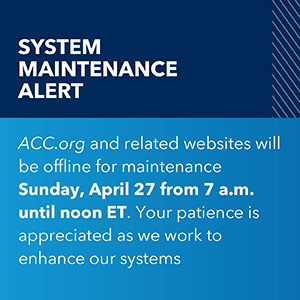Controlled Rosuvastatin Multinational Trial in Heart Failure - CORONA
Description:
The goal of the trial was to evaluate treatment with rosuvastatin compared with placebo in older patients with systolic heart failure.
Study Design
- Blinded
- Placebo Controlled
- Randomized
Patients Enrolled: 5,011
Mean Follow Up: 32.8 months
Mean Patient Age: 73 years
Female: 24%
Patient Populations:
Age ≥60 years; chronic NYHA class II, III, or IV heart failure of ischemic cause; ejection fraction ≤40% (≤35% in patients in NYHA class II); did not need treatment with a cholesterol-lowering drug; stable on optimal treatment for at least 2 weeks before randomization
Exclusions:
Previous statin-induced myopathy or hypersensitivity reaction; decompensated heart failure or a need for inotropic therapy; MI within the past 6 months; unstable angina or stroke within the past 3 months; percutaneous coronary intervention (PCI), coronary-artery bypass grafting (CABG), or the implantation of a cardioverter defibrillator or biventricular pacemaker within the past 3 months or a planned implantation of such a device; previous or planned heart transplantation; clinically significant, uncorrected primary valvular heart disease or a malfunctioning prosthetic valve; hypertrophic cardiomyopathy; acute endomyocarditis or myocarditis, pericardial disease, or systemic disease; acute or chronic liver disease; levels of alanine aminotransferase or thyrotropin >2 times ULN; a serum creatinine level >2.5 mg/dl; chronic muscle disease or an unexplained creatine kinase level >2.5 times ULN; previous treatment with cyclosporine; any other condition that would substantially reduce life expectancy or limit compliance with the protocol; or the receipt of <80% of dispensed placebo tablets during the run-in period
Primary Endpoints:
Death from CV causes, nonfatal MI, or nonfatal stroke
Secondary Endpoints:
Death from any cause, any coronary event, death from CV causes, and the number of hospitalizations
Drug/Procedures Used:
Following a 2- to 4-week placebo run-in phase, patients were randomized in a double-blind manner to rosuvastatin (n = 2,514; 10 mg) or placebo (n = 2,497).
Principal Findings:
Mean ejection fraction at baseline was 31%. The majority of patients were New York Heart Association (NYHA) class III heart failure (62%). Average blood pressure was 129/76 mm Hg. Prior coronary heart disease was common, with 60% of patients having a prior myocardial infarction (MI), and 73% having prior or current angina. Diabetes was present in 30% of patients.
Low-density lipoprotein (LDL) levels were reduced in the rosuvastatin group from 137 mg/dl at baseline to 76 mg/dl at 3 months, but did not change in the placebo group (136 mg/dl at baseline and 138 mg/dl at 3 months; p < 0.001 between groups). Likewise, C-reactive protein (CRP) levels were reduced in the rosuvastatin group from 3.1 mg/dl at baseline to 2.1 mg/dl at 3 months, but increased in the placebo group (3.0 mg/dl at baseline and 3.3 mg/dl at 3 months; p < 0.001 between groups).
The primary endpoint of cardiovascular (CV) death, MI, or stroke did not differ significantly between groups (11.4 for rosuvastatin vs. 12.3 for placebo per 100 years of follow-up, hazard ratio [HR] 0.92, 95% confidence interval [CI] 0.83-1.02; p = 0.12). There was also no difference between the groups in the secondary endpoints of all-cause death (11.6 vs. 12.2 placebo per 100 years of follow-up, HR 0.95, 95% CI 0.86-1.05; p = 0.31) or any coronary event (9.3 vs. 10.0 placebo per 100 years of follow-up, HR 0.92, 95% CI 0.82-1.04; p = 0.18).
Hospitalizations for CV causes occurred less frequently in the rosuvastatin group compared with the placebo group (HR 0.92, 95% CI 0.85-0.99, p = 0.04 for first event; p < 0.001 for multiple events). Hospitalization for heart failure was similar between groups (HR 0.91, 95% CI 0.82-1.02; p = 0.105); however, when repeat events were considered, rosuvastatin was associated with a significant reduction in hospitalization for heart failure (HR 0.82, 95% CI 0.72-0.92; p = 0.001). There was no difference in change in NYHA class between groups. There was also no difference in muscle-related or other adverse events between groups.
.
Interpretation:
Among patients with systolic heart failure, lipid-lowering therapy with rosuvastatin was not associated with a reduction in the primary endpoint of CV death, MI, or stroke at a median follow-up of 32.8 months compared with placebo.
Despite effectively reducing LDL, triglycerides, and CRP with rosuvastatin, there was no impact on clinical events, other than CV hospitalizations. These findings were observed despite the high levels of prior coronary disease in the population. The authors noted that low total cholesterol levels in this population have actually been associated with worse outcomes in prior studies. While there was no significant benefit on clinical events, except reduction in hospitalization for CV causes and heart failure, there was also no evidence of harm associated with the reduction in LDL levels in the present study of older patients with relatively severe systolic dysfunction.
References:
Kjekshus J, Apetrei E, Barrios V, et al. Rosuvastatin in older patients with systolic heart failure. N Engl J Med 2007;357:2248-61.
Rogers JK, Jhund PS, Perez AC, et al. Effect of Rosuvastatin on Repeat Heart Failure Hospitalizations: The CORONA Trial (Controlled Rosuvastatin Multinational Trial in Heart Failure). JACC Heart Fail 2014;Apr 30:[Epub ahead of print].
Presented by Dr. Åke Hjalmarson at the American Heart Association Annual Scientific Session, Orlando, FL, November 2007.
Clinical Topics: Cardiovascular Care Team, Diabetes and Cardiometabolic Disease, Dyslipidemia, Heart Failure and Cardiomyopathies, Hypertriglyceridemia, Lipid Metabolism, Nonstatins, Novel Agents, Statins, Acute Heart Failure, Chronic Heart Failure, Heart Failure and Cardiac Biomarkers
Keywords: Fluorobenzenes, Stroke, Myocardial Infarction, Hydroxymethylglutaryl-CoA Reductase Inhibitors, Pyrimidines, Blood Pressure, Heart Failure, Systolic, Lipoproteins, LDL, C-Reactive Protein, Triglycerides, Hospitalization, Diabetes Mellitus, Sulfonamides

